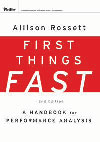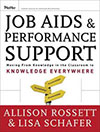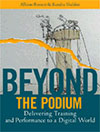Meet Jeff Loube
My guest blogger is Jeff Loube. Jeff describes himself as a practitioner who has completed analysis and design projects such as basic, multi-engine and rotary wing pilot training, maintenance training systems, and maintenance training simulator design, prototyping and development. Jeff is managing editor of MS&T (Military Simulation and Training) magazine, http://halldale.com/mst
Here is what Jeff has to say about introducing new technology into the organization.
Have you ever been the victim of a new technology initiative, like say a new LMS or a mobile learning initiative or even a new accounting system? They rarely work out as the techies say they will, but rather too often create a painful experience for all concerned.
Last year, speaking to a conference of aviation trainers, John Alonso, CTO, OutStart, observed that ninety percent of mobile learning pilot projects he is aware of have failed. Ninety percent! Why? The reason was that the implementations were not being driven by a business problem, but rather by the coolness of the technology. This was a technology solution, in this case mobile devices, looking for a problem.
A decade or so ago, I discovered Rob Kling and his paper about IT and organizational change. It is written in a way that makes sense to me. He provided a basic framework for planning and executing less painful technological change. Note, he didn’t promise no pain at all, just less of it. The part of the paper that resonated with me was the definition of the two contrasting approaches – a standard “tool view” approach vs. a sociotechnical approach.
Kling shows that the standard “tool view” is insufficient to support the organisational change required to develop new ways of doing business. And he shows how the socio-technical approach is far superior for supporting technology innovation and organizational change. The key differences between the standard tool view model and a socio-technical model illustrate the challenges of– and provide a framework for – implementation strategies that minimise pain and reduce the risk of failure.
|
In Standard (Tool) Models |
In SocioTechnical Models |
|
IT is a tool |
IT is a sociotechnical system |
|
A narrow view of the Business model is sufficient |
A wide ecological view is needed that recognizes all aspects of the business |
|
Implementation is an event |
Implementation is an ongoing process |
|
Technological effects are direct and immediate |
Technological effects are indirect and rolled out over time |
|
Politics are bad or irrelevant |
Politics are central and even enabling |
|
Incentives to change don’t matter. The technology will sell itself. |
Incentives do matter and may require business restructuring |
|
Relationships are easily reformed |
Relationships are complex, negotiated, and multi-valent. |
|
Social effects of IT are big but isolated and benign |
Potentially enormous social repercussions from IT |
|
Context is simple (described by a few key terms or demographics) |
Context is complex (matrices of businesses, services, people, technology history, location, etc.) |
|
Knowledge and Expertise are easily made explicit |
Knowledge and Expertise are inherently tacit/implicit and difficult to tease out |
|
IT Infrastructure are fully supportive |
Articulation needed to make IT work |
In 1999, when the paper was written, Kling observed “Unfortunately, the standard model still underpins many of the stories about electronic commerce that appear in the professional and popular business and technological magazines. The major predictive error that results from relying upon this model is that one overestimates the ease of “going digital” by substantially underestimating the complexity and time of the required organizational change.”
I don’t believe much has changed. The standard tool model that Kling describes continues to thrive.
Implicit in the comparison of the two models is that in the tool view, the technology itself is instrumental in the decision to adopt the technology. On the other hand, the socio-technical model invites a more critical view of the why behind the technology purchase and an overall systems approach to the decision to purchase and implementation, planning and execution.
If you are going to implement using Kling’s socio technical approach, you would:
- Take a systems approach, and be aware of, and address the business processes and governance that will free or constrain the results. People and their relationships are integral part to the system. Workers’ and clients’ (internal or external) response to the technology and the way it is implemented will make or break the system.
- Be prepared to navigate organisational culture (the way we do things here) and the politics associated with culture.
- Communicate with stakeholders. Use pilots to demonstrate the advantages of the system and highlight incentives to change. Not only must stakeholders perceive the benefits that will accrue to them, the benefits must materialise. Ensure that these expectations are realistic.
- Ensure that initial and continuation training is personalised (one size does not fit all) and that it focuses on the task, not the tool. Relevancy and business are key here.
- Ensure there is accessible and ongoing support. Consider facilitating ongoing social learning by training and using local experts who understand the work that people are performing.
- Be prepared for changes in job functions and roles, and provide support – selection, training, mentoring, and/or coaching –whatever tactic works for your organisation. The introduction of new technology is usually accompanied by major changes in the organisation of work; and
- Finally, be skeptical of those who say it will be easy to convert with existing resources. It never is. It will take extra resources and time. Data bases need to be migrated, courseware redesigned, rules changed, policies adjusted, regulators appeased, unions consulted, and so on. Plan for long term investment and support.
As Kling wrote “A socially rich view of highly digital and mixed digital products and services—one that follows a sociotechnical model rather than the standard model—can help policymakers and practitioners anticipate some of the key organizational shifts that accompany introductions of new technologies.” And, I might add, avoid the “tool view” pain.
Kling, R. (1999). IT and organizational change in digital economies: A socio-technical approach. Computers and Society, 29(3), 17-25.
Jeff started his working life as a naval deck officer, and slid into a second career in the simulation and training industry on retirement from the navy. Contact him at jeff@halldale.com






